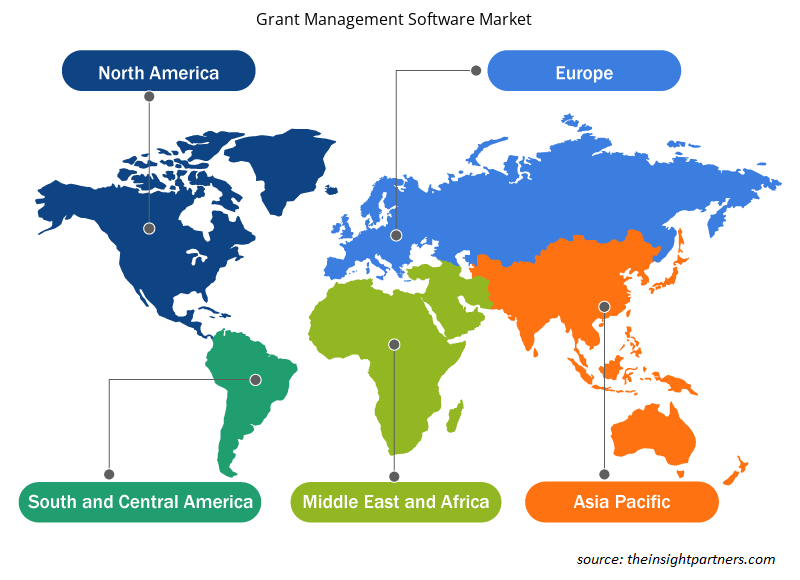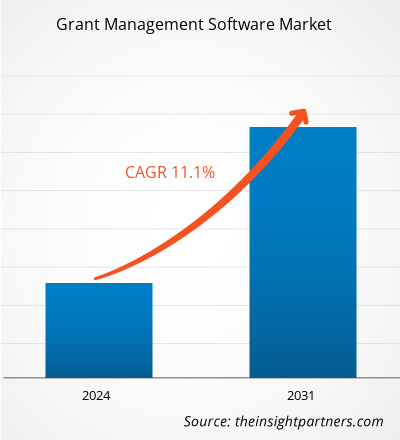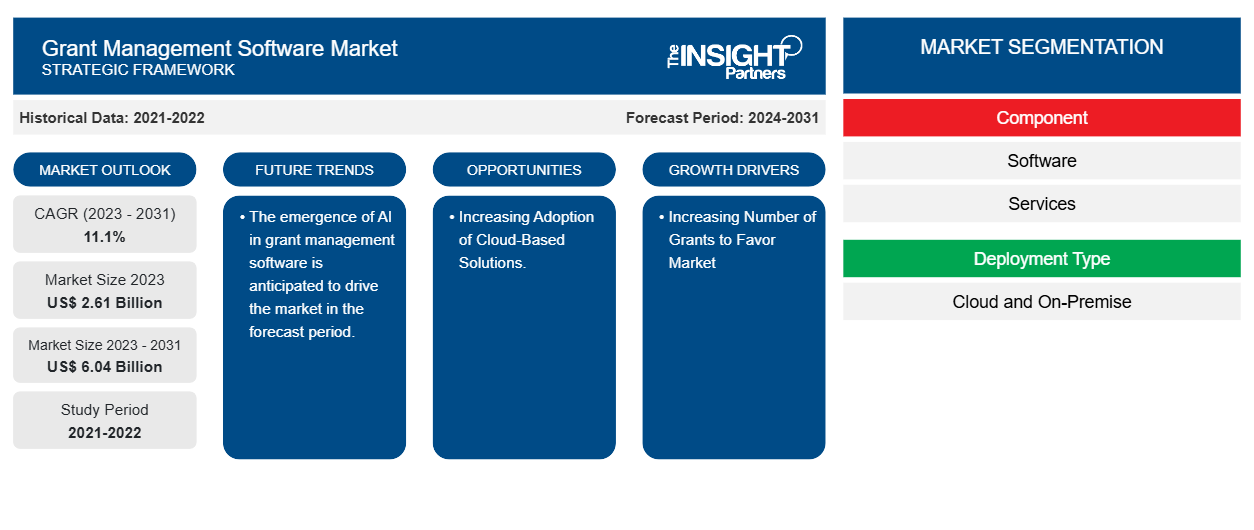Si prevede che la dimensione del mercato del software di gestione delle sovvenzioni raggiungerà i 6,04 miliardi di dollari entro il 2031, rispetto ai 2,61 miliardi di dollari del 2023. Si prevede che il mercato registrerà un CAGR dell'11,1% nel periodo 2023-2031.È probabile che il numero crescente di sovvenzioni e la crescente adozione di soluzioni basate sul cloud rimangano tendenze e motori chiave del mercato.
Analisi di mercato del software di gestione delle sovvenzioni
La crescente domanda di software di gestione delle sovvenzioni tra le aziende è uno dei principali fattori che alimentano il mercato dei software di gestione delle sovvenzioni. Inoltre, il software di gestione delle sovvenzioni semplifica il processo di richiesta e genera in modo efficiente descrizioni di diversi programmi di finanziamento. Il software di gestione delle sovvenzioni consente alle organizzazioni di monitorare le prestazioni e velocizzare procedure come la rendicontazione, il miglioramento delle prestazioni contabili e il monitoraggio e gli audit in modo appropriato.
Panoramica del mercato del software di gestione delle sovvenzioni
La gestione delle sovvenzioni è il metodo di gestione dell'intero ciclo di vita delle donazioni filantropiche, dalla domanda e idoneità alle revisioni e valutazioni delle domande, fino alla distribuzione delle sovvenzioni e al monitoraggio dei risultati in tempo reale. È uno strumento organizzativo che aiuta qualsiasi organizzazione a gestire tutto ciò che riguarda le sovvenzioni. Il software consente di tenere traccia di tutte le sovvenzioni per cui si è fatta domanda e di tutte le sovvenzioni assegnate.
Personalizza questo report in base alle tue esigenze
Riceverai la personalizzazione gratuita di qualsiasi report, comprese parti di questo report, o analisi a livello nazionale, pacchetto dati Excel, oltre a usufruire di grandi offerte e sconti per start-up e università
- Scopri le principali tendenze di mercato in questo rapporto.Questo campione GRATUITO includerà analisi di dati che spaziano dalle tendenze di mercato alle stime e alle previsioni.
Driver e opportunità di mercato per il software di gestione delle sovvenzioni
Aumento del numero di sovvenzioni per favorire il mercato
Numerose aziende nei paesi in via di sviluppo forniscono software personalizzati per i concedenti e i beneficiari delle sovvenzioni per semplificare il processo di concessione. L'implementazione di apprendimento automatico (ML), analisi e altre tecnologie avanzate consente decisioni basate sui dati per aiutare il ritorno sugli investimenti delle sovvenzioni.
Diverse associazioni stanno offrendo finanziamenti a fondo perduto. Ad esempio, nell'aprile 2023, il Department of Transportation Federal Highway Administration ( FHWA ) ha offerto finanziamenti a fondo perduto disponibili per un nuovo programma pilota per rendere le strade più sicure, prevenire le collisioni tra animali selvatici e veicoli e migliorare la connettività degli habitat. L'Infrastructure Investment and Jobs Act ( IIJA ) ha istituito il Wildlife Crossing Pilot Program per consentire agli stati e alle comunità di costruire attraversamenti per animali selvatici su strade trafficate, aggiungere segnali di avvertimento per i veicoli e ottenere attrezzature di mappatura e tracciamento per gli animali .
Crescente adozione di soluzioni basate su cloud.
La soluzione cloud viene fornita in un pacchetto all-in-one che comprende controllo completo e prevedibilità delle spese, inclusi uptime, hosting, licenze software, supporto, manutenzione, patch software e correzioni di bug. In base alla personalizzazione, le soluzioni basate su cloud possono essere implementate in pochi giorni o potrebbero richiedere alcune settimane. I clienti possono accedere al software basato su cloud utilizzando dispositivi esistenti come tablet o smartphone. La soluzione basata su cloud elimina la necessità di sviluppare connessioni remote sicure, come reti private virtuali che regolano la velocità. Pertanto, l'implementazione e la manutenzione a basso costo della soluzione guidano in modo significativo il mercato del software di gestione di grandi dimensioni nei paesi sviluppati e in via di sviluppo. Seabrooks fornisce un sistema di gestione delle sovvenzioni di impatto sulla comunità basato su cloud di facile utilizzo. PyanGo offre software per istituti scolastici e organizzazioni non profit, completamente integrato con la piattaforma cloud Oracle NetSuite.
Analisi della segmentazione del rapporto di mercato del software di gestione delle sovvenzioni.
I segmenti chiave che hanno contribuito alla derivazione dell'analisi di mercato del software di gestione delle sovvenzioni sono i componenti, il tipo di distribuzione, le dimensioni dell'organizzazione e l'utente finale.
- In base al componente, il mercato del software di gestione delle sovvenzioni è suddiviso in software e servizi. Si prevede che il segmento software manterrà una quota di mercato significativa nel periodo di previsione.
- In base al tipo di distribuzione, il mercato del software di gestione delle sovvenzioni è suddiviso in cloud e on-premise. Si prevede che il segmento cloud detenga una quota di mercato significativa nel periodo di previsione.
- In base all'utente finale, il mercato è segmentato in istituti educativi, governo, BFSI, organizzazioni non-profit e assistenza sanitaria. Si prevede che il segmento governativo detenga una quota di mercato significativa nel periodo di previsione.
Analisi della quota di mercato del software di gestione delle sovvenzioni per area geografica
L'ambito geografico del rapporto di mercato sul software di gestione delle sovvenzioni è suddiviso principalmente in cinque regioni: Nord America, Asia Pacifico, Europa, Medio Oriente e Africa, Sud e Centro America.
Il Nord America ha dominato il mercato del software di gestione delle sovvenzioni. Il Nord America è costituito da Stati Uniti, Canada e Messico. I progressi tecnologici hanno portato a un mercato altamente competitivo nella regione poiché gli sviluppi tecnologici attraggono popolazioni in crescita grazie all'elevato potere di spesa. Il mercato del software di gestione delle sovvenzioni in Nord America è maturo grazie alla presenza sproporzionata di organizzazioni con la disponibilità di competenze tecniche e infrastrutture IT avanzate. Inoltre, una forte enfasi sulla ricerca e sviluppo nelle economie sviluppate di Stati Uniti e Canada sta costringendo gli operatori nordamericani a portare soluzioni tecnologicamente avanzate sul mercato. Inoltre, gli Stati Uniti hanno un gran numero di operatori del mercato del software di gestione delle sovvenzioni che si sono sempre più concentrati sullo sviluppo di soluzioni innovative. Tutti questi fattori contribuiscono alla crescita del mercato del software di gestione delle sovvenzioni nella regione.
Approfondimenti regionali sul mercato del software di gestione delle sovvenzioni
Le tendenze regionali e i fattori che influenzano il Grant Management Software Market durante il periodo di previsione sono stati ampiamente spiegati dagli analisti di Insight Partners. Questa sezione discute anche i segmenti del Grant Management Software Market e la geografia in Nord America, Europa, Asia Pacifico, Medio Oriente e Africa e Sud e Centro America.

- Ottieni i dati specifici regionali per il mercato del software di gestione delle sovvenzioni
Ambito del rapporto di mercato sul software di gestione delle sovvenzioni
| Attributo del report | Dettagli |
|---|---|
| Dimensioni del mercato nel 2023 | 2,61 miliardi di dollari USA |
| Dimensioni del mercato entro il 2031 | 6,04 miliardi di dollari USA |
| CAGR globale (2023-2031) | 11,1% |
| Dati storici | 2021-2022 |
| Periodo di previsione | 2024-2031 |
| Segmenti coperti | Per componente
|
| Regioni e Paesi coperti | America del Nord
|
| Leader di mercato e profili aziendali chiave |
|
Densità degli attori del mercato: comprendere il suo impatto sulle dinamiche aziendali
Il mercato del Grant Management Software Market sta crescendo rapidamente, spinto dalla crescente domanda degli utenti finali dovuta a fattori quali l'evoluzione delle preferenze dei consumatori, i progressi tecnologici e una maggiore consapevolezza dei vantaggi del prodotto. Con l'aumento della domanda, le aziende stanno ampliando le loro offerte, innovando per soddisfare le esigenze dei consumatori e capitalizzando sulle tendenze emergenti, il che alimenta ulteriormente la crescita del mercato.
La densità degli operatori di mercato si riferisce alla distribuzione di aziende o società che operano in un particolare mercato o settore. Indica quanti concorrenti (operatori di mercato) sono presenti in un dato spazio di mercato in relazione alle sue dimensioni o al valore di mercato totale.
Le principali aziende che operano nel mercato del software per la gestione delle sovvenzioni sono:
- Società di software StreamLink Inc.
- Società di consulenza informatica
- Giornata lavorativa Inc.
- Fluxx Labs Inc.
- Oracle Corporation
- Società per azioni Salesforce Inc.
Disclaimer : le aziende elencate sopra non sono classificate secondo un ordine particolare.

- Ottieni una panoramica dei principali attori del mercato del software di gestione delle sovvenzioni
Notizie di mercato e sviluppi recenti del software di gestione delle sovvenzioni
Il mercato del software di gestione delle sovvenzioni viene valutato raccogliendo dati qualitativi e quantitativi dopo la ricerca primaria e secondaria, che include importanti pubblicazioni aziendali, dati associativi e database. Di seguito sono elencati alcuni degli sviluppi nel mercato del software di gestione delle sovvenzioni:
- GivingData, uno dei principali fornitori di software per la gestione delle sovvenzioni a fondazioni familiari e indipendenti, ha annunciato il lancio di un nuovo programma di consulenza per partner per aiutare le fondazioni che erogano sovvenzioni a ottimizzare l'uso della piattaforma di gestione delle sovvenzioni aziendali dell'azienda. (Fonte: GivingData, sito Web aziendale, dicembre 2023)
- SmartSimple Software, uno dei principali fornitori di soluzioni basate su cloud per la gestione delle sovvenzioni e le donazioni aziendali, ha annunciato il lancio di SmartSimple Cloud +AI. Questo prodotto ha introdotto un supporto AI trasformativo end-to-end durante l'intero ciclo di vita della gestione delle sovvenzioni, semplificando il processo e riducendo ulteriormente l'onere amministrativo. (Fonte: SmartSimple Software, sito Web aziendale, marzo 2023)
Copertura e risultati del rapporto di mercato sul software di gestione delle sovvenzioni
Il rapporto "Dimensioni e previsioni del mercato del software di gestione delle sovvenzioni (2021-2031)" fornisce un'analisi dettagliata del mercato che copre le seguenti aree:
- Dimensioni e previsioni del mercato del software di gestione delle sovvenzioni a livello globale, regionale e nazionale per tutti i segmenti di mercato chiave coperti dall'ambito
- Tendenze del mercato del software di gestione delle sovvenzioni e dinamiche di mercato come driver, vincoli e opportunità chiave
- Analisi dettagliata delle cinque forze PEST/Porter e SWOT
- Analisi di mercato del software di gestione delle sovvenzioni che copre le principali tendenze del mercato, il quadro globale e regionale, i principali attori, le normative e i recenti sviluppi del mercato
- Analisi del panorama industriale e della concorrenza che copre la concentrazione del mercato, l'analisi della mappa di calore, i principali attori e gli sviluppi recenti per il mercato del software di gestione delle sovvenzioni
- Profili aziendali dettagliati
- Analisi storica (2 anni), anno base, previsione (7 anni) con CAGR
- Analisi PEST e SWOT
- Valore/volume delle dimensioni del mercato - Globale, Regionale, Nazionale
- Industria e panorama competitivo
- Set di dati Excel
Report recenti
Rapporti correlati
Testimonianze
Motivo dell'acquisto
- Processo decisionale informato
- Comprensione delle dinamiche di mercato
- Analisi competitiva
- Analisi dei clienti
- Previsioni di mercato
- Mitigazione del rischio
- Pianificazione strategica
- Giustificazione degli investimenti
- Identificazione dei mercati emergenti
- Miglioramento delle strategie di marketing
- Aumento dell'efficienza operativa
- Allineamento alle tendenze normative























 Ottieni un campione gratuito per - Mercato del software di gestione delle sovvenzioni
Ottieni un campione gratuito per - Mercato del software di gestione delle sovvenzioni